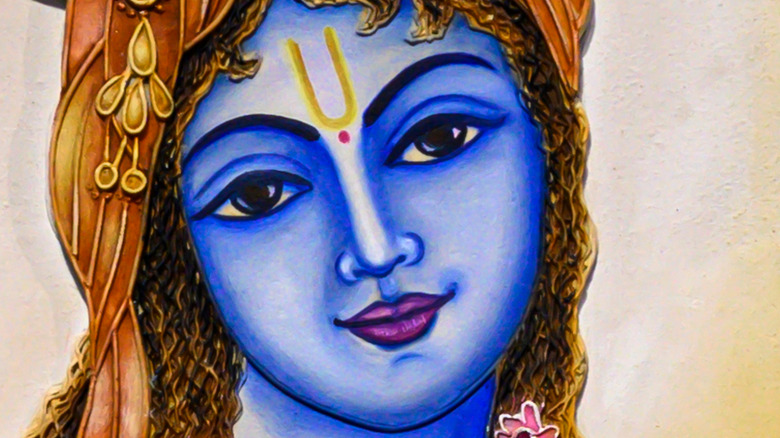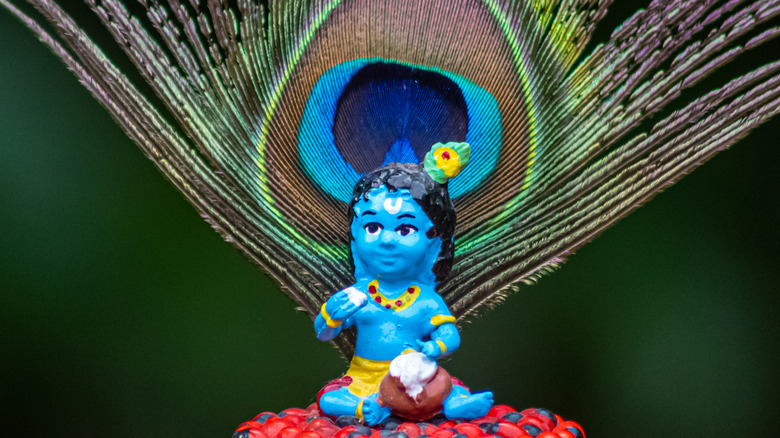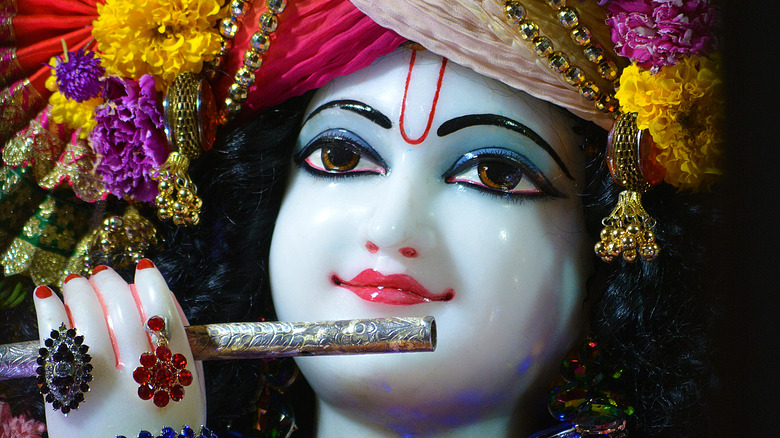Why Krishna's Skin Is Portrayed Blue Or Black In Art
Krishna, also known as Sri Krishna, Krsna, or Hari Krishna, is one of the most powerful and revered gods within the Hindu pantheon. Per the World History Encyclopedia, Krishna is considered the eighth incarnation of Vishnu, who is a member of the Hindu holy trinity, along with Brahma and Shiva, and considered the most important god within Vaishnaism, which is the largest Hindu sect. Krishna is also a beloved hero in Hindu mythology; stories featuring his feats and quests appear in Hindu religious texts including the "Bhagavad Gita" and the "Puranas," which describes him as "Supreme Being and creator of the universe."
According to Behind The Name, "Krishna" means "black, dark" in Sanskrit. The site includes a depiction of Krishna with black skin, and notes that the god is often portrayed in artwork with blue skin. As reported by Slightly Blue, there are many possible reasons for this portrayal. Blue can be used to portray a spiritual aura, particularly when it's blue skin. In terms of mythology, there are two stories about Krishna that attempt to explain his blue skin. In one, he drank poisoned milk from Poothana the demoness; in another, the serpent king Kalinga's venom was responsible, and it happened after the two battled in a river.
Blue skin in religion and in science
The Isha Foundation notes that Krishna, along with other Hindu gods, including Shiva and Rama, is often depicted with blue skin. It's not that their actual skin is blue, but rather their auras, which then makes their skin merely appear blue. Writer Sadhguru defines an aura as "a certain field of energy that is around every substance" and calls blue "the basis of all-inclusiveness." He notes that because of his blue aura, Krishna was incredibly appealing and attractive to people, noting that Poothana was actually sent to kill him when he was a baby but instead fell in love with him, all because of the blue energy surrounding him. Sadhguru goes on to explain that those with blue auras are seen as "superhuman" by other people. The color blue indicates someone with massive dynamism who may be at the highest possible point in their evolution but still chooses to be active within the living world.
Slightly Blue reports that there is an actual scientific reason that some people have blue skin. Methemoglobinemia is a skin condition in which hemoglobin within the blood can't distribute oxygen throughout the body, and the lack of oxygen leads to the skin developing a blue tint. Skin can also turn blue when people are exposed to various substances, including nitrates and uranium; in 2009, there was reportedly a slew of babies in Punjab, India whose skin turned blue in response to an increase in the use of chemical fertilizers. This was referred to as Blue Baby Syndrome, and similar issues were seen in Bulgaria and Romania.
Why are Krishna and other gods portrayed as fair-skinned?
In 2018, the BBC reported on a campaign within India to reconsider the ways in which Hindu deities had been portrayed in popular culture. For example, despite the fact that Krishna himself is described as dark-skinned in Hindu scriptures, and that Ganesha has the head of an elephant, both they and other gods are often portrayed as light-skinned (there are no white elephants in India). According to Bharadwaj Sundar, who films advertisements, "All the images of the popular gods and goddesses that we see around us, photographs in our home shrines or prayer halls, online, on calendars, stickers and posters in shops and pasted behind auto-rickshaws, all show them to be light-skinned."
Sundar and photographer Naresh Nil developed a project they called "Dark Is Divine," which specifically focused on depicting gods and goddesses with dark skin. One model, Suruthi Periyasamy, portrayed Lakshmi, the goddess of wealth, and told the reporter, "Lakshmi is the most popular goddess in India, everyone wants a daughter-in-law like her because she brings prosperity so I feel so blessed to be her." She went on to explain that she's heard a lot of talk regarding people wanting to work with dark-skinned models, but it's rare that this talk is actually put into action.
Sundar's reasons for creating the Dark Is Divine project is partially personal: "Everyone here prefers fair skin. But I am a dark-skinned person and all my friends are dark-skinned too. So how do I identify with fair-skinned gods and goddesses?"


